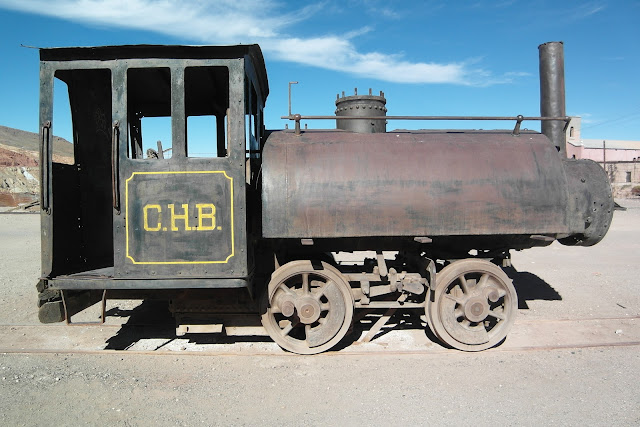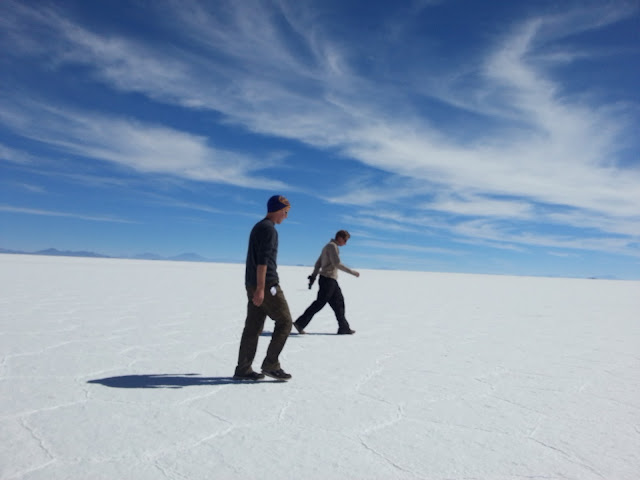If you’ve ever regarded the melancholy colors of late sunset, pondering the lost and broken things in life, and in the all-encompassing discretion of the twilight allowed your soul unchained to scream “Why?! Why!? Why is there nothing, no video game or real-life experience which marries the high-stakes adrenaline of Frogger to the rapid-fire spatial reckoning of Tetris!!?” then Aaron, Sheldon and I have come to give you peace. The Peace. La Paz. The traffic of La Paz, specifically. A maelstrom and a geometry exam, all in one, it can be formidable.
And one crisp Tuesday morning, it was over. We climbed into the car, steeled our nerves, and left the city. Somehow, it was easy. Almost too easy. I’m not a superstitious man, but it was so easy it almost resulted in a sense of foreboding.
Our drive that day, other than easy traffic in La Paz, included the following: a group of vagrants (I assume: I was manning the wheel, not watching the underpass) who began to bellow at us as we passed through an intersection next to their underpass, a large, manically maneuvering bus that followed us into a merging situation, going 34,000,012 kph (21,126,626 mph for anyone who can’t do the math mentally), forced us into the wrong lane, then couldn’t pass us, then honked in outrage when it passed us later as we switched drivers on the side of the road. And then the coup de grace; we were detained by an angry young policeman who was very upset with us, and unfortunately did not seem to speak any language at all, in favor of an almost-Spanish mumble-slur-growl, which he delivered to us in outraged expostulation three times, each time ending by striding pompously to the middle of the road. In the end, we don’t know what he wanted, because he gave up, and let us go. We theorize that he was looking for a bribe, but several times when Aaron explicitly asked “What is it you need?” he made indecipherable noises at us. Quizzical is a fine word to use to describe our feelings.
Thanks to a unexpected attack of three-hours-of-dirt-roads-through-mountains, we bogged down, and were obliged to spend the night in a tiny village high in the mountains. On our way to the village, we spent 45 minutes listening to NPR’s Wait, Wait, Don’t Tell Me--probably the group’s favorite in-car activity--while a pair of bulldozers the same size as the ones they use to build mountain ranges messed around with the dirt road. Also, the hostel owner told us that he’s had visitors from North Korea, which we think was a lie.
The next day started well. We were rattling down the road, enjoying our new fuel pump and a retrospective play list of popular Christian rock tunes from our childhood when a man emerged from a small thicket of humanity beside the road and flagged for a ride. Noting the presence of what appeared to be an inoperable taxi beside his little thicket of people, we pulled over.
“How many?” we asked.
“Four.” he said.
“We can only take two.” we said.
“Oh, no, we’ll fit.” He said.
“No.” we said.
Actions speak louder than words. We used the word ’no,’ but he and his confederates made use of the more convincing action ’yes.’ The whole forest of person began to ripple and move, and we experienced emotions similar to those of Macbeth when he realized that an actual forest was moving, bringing with it his doom. In our case, we realized that four people were coming at our car. Four adults, that is. Plus six children. Plus two large bags, a small bag, a kettle of boiled potatoes, a yellow propane tank, and the odor of goat, more pungent and goatlike than any real goat I have ever encountered. Sheldon was engulfed and submerged, I was shoved into the center column, where I was obliged to share space with the shifter, the emergency break and the four-wheel drive control. Just behind me, floating on a cloud of goat, a small child was playing that game where you cough, and then cough again, and then you let a blob of snot the size of Godzilla slowly emerge from your nose, and when it’s approximately an inch down your upper lip, you suck it back in with a sound this chronicler can only describe as “Bubonic Plague”
Two hours later, about an hour after we discovered that their first statement of where they wanted to be dropped off was a disingenuous maneuver to get in the car, we reached a crisis point, in a village without gasoline. We told them--honestly--that we had enough gas to get three people into town, but not enough to transport thirteen. After some discussion, they decided to remain behind. So they took their kettle of boiled potatoes, their two large bags, their small bag, and leaving only the odor of goat, they disembarked, and we went off in something of a huff.
The huff proved temporarily inescapable. Thirty minutes down the road, on the very cusp of reaching Sucre, we found the road impassably filled with seemingly dead trucks. Investigating, we discovered that the truckers of Sucre were on strike--no one knew why, and that it would be at least four hours before the trucks moved. We investigated alternative routes, we baked in the sun, and we at last conceded that there was no hope of alternative passage, as we’d been told by a hopeless policeman, and a slew of women, gnawing globs of coca leaves and nodding at each other like a congress of Solomons.
Surprisingly, instead of their projected 7 pm, the behemoths lumbered from our path at about 5:30, allowing us the freedom to stumble into what is, in my severely limited experience, the nicest city in Bolivia. Our experiences there were uniformly pleasant, and clean, and untroubled by the incessant hang-ups and bizarre obstacles that seem to compose a great deal of Bolivian life. Except for having to wake up at six AM every morning to move the car to a different part of town.
After two whole days of refreshment, good food, a cheap city tour from a Swiss man named Michael, and one painful incident in which a street-vending sunglasses salesperson decided Aaron and I had been looking too long without any cash having changed hands, and chased us away with abrupt, angry cries, we departed for the Argentine border, thinking happy thoughts, and fairly content that the worst of Bolivia’s infrastructural arthritis was behind us.
For the record, we’d also have told you that the glass was half full.






















.JPG)
































